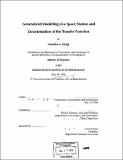| dc.contributor.advisor | Dava J. Newman. | en_US |
| dc.contributor.author | Neogi, Natasha A. (Natasha Anita), 1976- | en_US |
| dc.date.accessioned | 2010-01-07T20:50:36Z | |
| dc.date.available | 2010-01-07T20:50:36Z | |
| dc.date.copyright | 1999 | en_US |
| dc.date.issued | 1999 | en_US |
| dc.identifier.uri | http://hdl.handle.net/1721.1/50538 | |
| dc.description | Thesis (S.M.)--Massachusetts Institute of Technology, Dept. of Aeronautics and Astronautics, 1999. | en_US |
| dc.description | Includes bibliographical references (leaves 127-132). | en_US |
| dc.description.abstract | An elementary structural model of a modular space station, such as the Russian Space Station Mir or the International Space Station (ISS), was formulated using Euler-Bernoulli beam theory. Based on structural dynamic techniques and modal analysis, a generalized method for deriving a theoretical transfer function between astronaut force inputs and station acceleration outputs is postulated. The validity of this transfer function can then be examined using the experimental force and acceleration data collected from Mir from the period of 1996 to 1998. In order to quantify astronaut-induced disturbances to the microgravity environment onboard a space station during long duration spaceflight, the Enhanced Dynamic Load Sensors (EDLS) Spaceflight experiment measured the forces and moments exerted by astronauts on the Russian Space Station Mir. Approximately 95% of all processed astronaut motions possessed a maximum force less that 275 N, a root mean square force less than 60 N and a power spectral density less than 22 Hz. Thus, astronaut motions are not the most stringent of design constraints upon a space station. Coupled with accelerometer data from the Space Acceleration Measurement System (SAMS), forces from crew motions can be temporally correlated with the overall acceleration of the Mir Space Station. An operator similar to the Fourier transform is developed in order to convert the force and acceleration data from the time domain into the frequency domain. A least-squares approach is used in order to obtain the optimal transfer function between the force and acceleration experimental data. The maximum residue of this transfer function was found at the pole at 0.375 Hz with a magnitude of approximately 7.5x10 -6, which is in accord with transient time domain analysis performed previously. Unfortunately, due to a lack of collocation between the EDLS force plate sensors and the SAMS accelerometer heads, a meaningful comparison between the theoretical transfer function and the experimental transfer function could not be conducted. | en_US |
| dc.description.statementofresponsibility | by Natasha A. Neogi. | en_US |
| dc.format.extent | 148 leaves | en_US |
| dc.language.iso | eng | en_US |
| dc.publisher | Massachusetts Institute of Technology | en_US |
| dc.rights | M.I.T. theses are protected by
copyright. They may be viewed from this source for any purpose, but
reproduction or distribution in any format is prohibited without written
permission. See provided URL for inquiries about permission. | en_US |
| dc.rights.uri | http://dspace.mit.edu/handle/1721.1/7582 | en_US |
| dc.subject | Aeronautics and Astronautics | en_US |
| dc.title | Generalized modelling of a space station and determination of the transfer function | en_US |
| dc.type | Thesis | en_US |
| dc.description.degree | S.M. | en_US |
| dc.contributor.department | Massachusetts Institute of Technology. Department of Aeronautics and Astronautics | en_US |
| dc.identifier.oclc | 43584130 | en_US |
